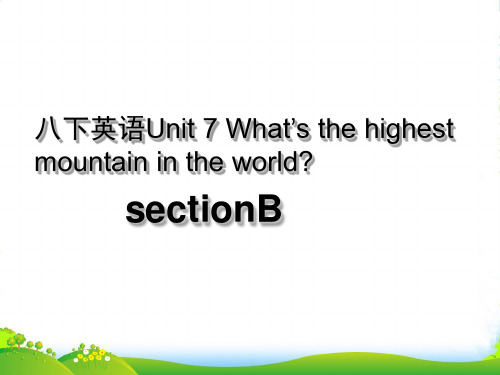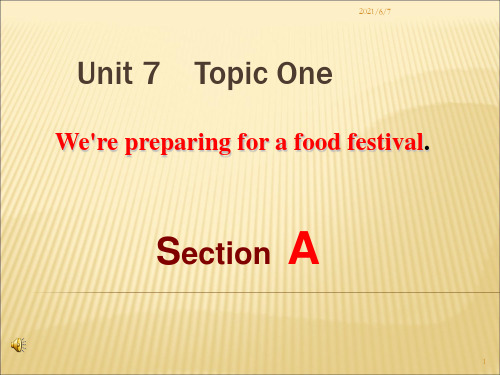公开课八年级下册英语第七单元第一课时
- 格式:ppt
- 大小:5.29 MB
- 文档页数:28





人教版八年级下册英语Unit7(第七单元)优秀教案Unit 7 What is the highest mountain in the world?第一课时Section A (1a-2d)【学习目标】1.重点单词:square,meter,deep,desert,population,Asia,wall,tour,tourist,ancient,protect,wide2.重点短语:man-made objects,as far as I know3.重点句式:Qomolangma is higher than any other mountain in the world.What is the highest mountain in the world?China has the biggest population in the world.It's a lot bigger than the population of the US.It has a much longer history than the US.China is almost as big as the US.Did you know that China is one of the oldest countries in the world?How long is the wall?The main reason was to protect China.As far as I know,there are no man-made objects as big as this.Is Badaling part of the Ming Great Wall?【学习重点】1.重点短语和句型2.形容词和副词比较级和最高级的用法【学习难点】1.重点短语和句型2.形容词和副词比较级和最高级的用法【自主学习】一、预习课本P49-50新单词并背诵,完成下面的汉译英。

Unit 7 What’s the highest mountain inthe world?单元分析本单元的主题是世界知识,通过谈论地理和自然景观,并能进行适当的对比;掌握大数字的读法以及具有比较功能的句式结构。
在Section A部分,从听、说技能入手,通过呈现“世界地理之最”的相关数据以及“中国之最”,学习大数字的表达方法,并学会不同的句式表达比较级、最高级。
Section B是对本单元主题的发展和纵深讨论,从自然和文化的比较过渡到了动物这一话题。
本部分呈现了大象、熊猫及熊猫研究基地的相关内容,通过听说读写等活动,引导学生学习更多表达比较的句式结构,了解大熊猫等濒危动物,培养保护动物的意识。
Period 1 Section A (1a-2d)本节课为第一单元的第一课时,课型为听说课。
主要学习内容为:1. 大数字的读法;2. 能运用形容词和副词的比较级和最高级谈论地理与自然。
教学目标1. 词汇:square, meter, deep, desert, population, Asia, tour, tourist, wall, ancient, protect, wide,feel free, as far as I know2. 句型:(1) —What’s the highest mountain in the world?—Qomolangma.(2) —How high is Qomolangma?—It’s 8,844.43 meters high. It’s higher than any other mountain.The Caspian Sea is the deepest of all the salt lakes.(3) —Did you know that China is one of the oldest countries in the world?—Yes, I did. It’s much older than the US.3. 能正确运用数词表述物体的长、宽、高等;能正确运用比较级和最高级谈论地理与自然。
八年级英语下册unit7课件(一)Unit 7: The WeatherTeaching Content•Vocabulary related to weather•Sentence structures for describing weather•Listening and speaking activities related to weather •Reading and writing activities related to weather Teaching Preparation•Prepare flashcards or visual aids for weather vocabulary •Prepare listening materials or videos related to weather •Prepare reading materials or texts related to weather •Prepare writing activities or prompts related to weather Teaching Objectives1.To introduce and practice weather vocabulary2.To provide opportunities for students to practicedescribing weather using appropriate sentence structures3.To improve students’ listening and speaking skillsthrough weather-related activities4.To enhance students’ reading comprehension skillsthrough weather-related texts5.To develop students’ writing skills by engaging them inweather-related writing tasksDesign ExplanationThe design of this lesson aims to engage students in various activities related to weather, allowing them to actively practice and consolidate their understanding of the vocabulary and sentence structures. The lesson includes a combination of listening, speaking, reading, and writing activities to cater to different learning preferences and skills.Teaching Process1.Warm-up activity:–Show pictures of different weather conditions and ask students to describe them using the appropriatevocabulary.–Play a short video or audio clip of different weather conditions and ask students to identifythem.2.Vocabulary introduction and practice:–Present weather vocabulary using flashcards or visual aids.–Drill the pronunciation and spelling of the weather words.–Engage students in various vocabulary practice activities such as matching, fill in the blanks, orword association games.3.Sentence structure practice:–Introduce sentence structures for describingweather (e.g., “It’s sunny today,” “It’sraining heavily”).–Provide examples and model the sentence structures.–Ask students to practice forming sentences to describe different weather conditions.4.Listening and speaking activities:–Play a weather-related listening activity or video.–Ask comprehension questions to check understanding.–Engage students in speaking activities such as pair or group discussions about their favorite weatheror their experiences in different weatherconditions.5.Reading activity:–Provide students with a short passage or text about different weather conditions.–Ask students to read the text and answercomprehension questions.–Discuss the main points and key details in the text.6.Writing activity:–Assign a writing task related to weather, such as writing a weather forecast or describing amemorable weather experience.–Provide prompts or guiding questions to helpstudents structure their writing.–Collect and review students’ written work,providing feedback and suggestions for improvement.Post-lesson ReflectionThis lesson successfully engaged students in various interactive activities related to weather. The use of visual aids, listening materials, reading texts, and writing tasks provided students with different opportunities to practice and apply their understanding of weather vocabulary and sentence structures. The lesson could be further improved by incorporating more group activities and opportunities for student interaction. Additionally, providing students with real-life weather scenarios or dialogues could make the lesson more practical and relatable.Unit 7: The Weather (Continued)Teaching Content•Vocabulary related to weather•Sentence structures for describing weather•Listening and speaking activities related to weather •Reading and writing activities related to weather Teaching Preparation•Review flashcards or visual aids for weather vocabulary•Prepare additional listening materials or videos related to weather•Find more reading materials or texts related to weather •Prepare more writing activities or prompts related to weatherTeaching Objectives1.To reinforce weather vocabulary and sentence structures2.To provide extended opportunities for students topractice describing weather in speaking and writingactivities3.To further improve students’ listening and speakingskills through weather-related activities4.To deepen students’ reading comprehension skillsthrough additional weather-related texts5.To expand students’ writing skills by engaging them inmore challenging weather-related writing tasksDesign ExplanationContinuing from the previous lesson, this lesson builds upon the students’ existing knowledge of weather vocabulary and sentence structures. The focus of this lesson is toprovide additional practice and extension activities to further develop their proficiency in describing weather. The lesson includes more listening, speaking, reading, and writing activities to reinforce their understanding and skills.Teaching Process1.Warm-up activity:–Review the weather vocabulary by playing aflashcard game or a quick vocabulary quiz.–Ask students to describe the weather conditions outside the classroom at that moment.2.Vocabulary and sentence structure reinforcement:–Review the sentence structures for describing weather.–Provide additional examples and ask students to create their own sentences using different weathervocabulary.3.Listening and speaking activities:–Play a weather-related dialogue or conversation.–Ask comprehension questions and engage students in discussions about the dialogue.–Arrange pair or group activities where students role-play different weather scenarios.4.Reading activity:–Provide students with an extended reading passage about weather phenomena or climate change.–Ask students to read the text and answer more in-depth comprehension questions.–Encourage students to share and discuss their opinions on the topic.5.Writing activity:–Assign a more advanced writing task related to weather, such as writing a persuasive essay on theimpact of weather on daily life.–Provide prompts and encourage students to conduct research or gather information to support theirarguments.–Provide feedback on students’ writing and guide them in improving their critical thinking andpersuasive writing skills.Post-lesson ReflectionBuilding upon the previous lesson, this lesson successfully reinforced students’ understanding of weather vocabulary and sentence structures. The additional listening, speaking, reading, and writing activities provided opportunities for students to apply these language skills in various contexts. Students were able to engage in more in-depth discussions and express their opinions on weather-related topics. To further enhance the lesson in the future, incorporating real-life weather data, multimedia resources, or interactive online platforms relating to weather could make the learning experience more dynamic and captivating.。
Unit 7 What is the highest mountain in the world?Section A教材分析通过谈论有关地理和自然的话题,进一步学习学习形容词和副词的比较级和最高级的用法,学会用形容词和副词的最高级来描述个人喜好。
单元教学内容话题:Which is the highest mountain in the world?功能: 1. 大数字的读法和表示度量的结构2. 比较级和最高级的使用。
教学目标【知识与能力目标】1、能力目标:(1)能够听懂用比较级和最高级来讨论世界之最(2)掌握和运用新单词和短语来描述珠穆朗玛的相关地理知识。
2、知识目标:(1)能听说读写课文中出现大纲要求掌握的单词。
(2)要知道必计较最高级的用法。
【过程与方法目标】直观教学法、情景教学、探究型教学法【情感态度价值观目标】1、通过学习培养学生热爱大自然,保护环境的意识;2、通过对珠穆朗玛的相关地理知识的学习,培养学生热爱大自然和遇到困难永不言弃的拼搏精神。
教学重难点【教学重点】1. 学习较大数字的表述。
2. 学会用不同句式表达比较级、最高级。
【教学难点】形容词比较级、最高级的不同表达句式,如higher then any other mountain ,a lot bigger than,almost as big as等。
学生需要大量的口头练习对比,才能把握目标语言并达到熟练运用。
课前准备多媒体设备,智慧课堂教师平板教学过程一、创设情境1. 询问学生最喜欢的科目,让学生猜猜我喜欢的科目。
T:What is your favorite subject?Can you guess what my favorite subject is?向学生介绍自己最喜欢的学科是地理由此引入这节课的学习。
2.通过图片向学生展示四个“世界之最”的风景名胜引入接下来的学习。
3. 让学生完成课本1a的练习,让学生进一步了解这些“世界之最”的基本情况。
公开课教案(仁爱英语八下Unit 7 Topic1 Section A 1a-1c)授课班级:授课教师:授课时间:一、教学目标:1、知识目标:(1)掌握词汇:task, poster, touch, success,get in touch with, try onehave/hold a food festival, (Kenya, Craig Kielburger, Free the Children了解词汇)(2)语法:初步了解that引导的宾语从句。
2、能力目标:(1) 通过本课学习,让学生能开口说英语谈论Craig Kielburger 和Free the Children.(2)通过学习,让学生能够用宾语从句转述他人的言语。
3、情感目标:通过本课学习,让学生懂得珍惜自己的校园生活并努力学习,同时懂得关心帮助他人。
二、教学重难点:1、教学1a 对话让学生掌握1a 的主要内容和关键词汇及了解宾语从句是本课的教学重点2、让学生积极参与课堂活动,用宾语从句转述他人言语是本课的难点。
三、教学过程:Step 1 Lean-inShow some pictures and talk about them to lead into this topic.Step 2 Presentation and consolidation1.Know about Craig Kielburger and Free the Children (do Part 1 of 1a)1)Listen and fill in the form.2)Read and answer the questions.3)Listen and repeat the dialogue and explain it briefly.4)Retell the main idea of this small dialogue by filling the blanks.2.Know about the Food Festival (do Part 2 of 1a)1)Show a picture and say “ They try to build a school in Kenya. But they don have enough money. ”2)Talk about “ how to raise money to help them? ” Then lead to Part2 of1a.3)Listen and answer the questionWhat will Kangkang and his friends do to help them raise money?4)Read the dialogue and match their tasks for the food festival.5)Read the dialogue and repeat to try to remember their tasks .6)Fill in the blanks7)Read the whole dialogue together3.Learn the grammar --- Object Clauses1)Lead in by asking and answeringWhat does Kangkang say? (Craig is from Canada.)f He says Craig is from Canada.What does Maria say? (Free the Children has built over 700 school rooms in many countries.)— She says Free the Children has built over 700 school rooms in many countries.What does Jane say? (Young people raised most of the money.)一 She says young peopl毋aised most of the money.2)Explain and sum up the Object Clauses.4.Exercise and practice.Step 3 Make more sentences with object clause to talk about how to help poor people.If you have a chance to help poor people, what will you do for them?For example: I think I will...Step 4 Summary and Homework.Summary:1.Some new words: task, poster, touch, success ,2.Some newphrases: turn to, get in touch with, try one ' s best,have/hold a food festival, make a poster3.Object clauses guided by that1).Maria says she will turn to their teachers.2).Michael says his task is to make a poster.3).She says she will think about how to hold the food festival.4.Know sth about Craig Kielburger and Free the Children, and talk about how to help poor people.Homework:1.熟读生词及短语并抄写在作业本上(3遍).2.熟读课文1a对话3遍以上.3.完成导学案第5题4.完成《同步练习》SA.四、板书设计:Unit 7 Topic 1 Section AWords and phrases:turn toFree the ChildrenCraig KielburgerKenyatry one s besthave a food festivaltaskposter --- make a postertouch --- get in touch withsuccess —— make it a success五、教学总结及反思本节课主要是让学生谈论Craig Kielburger及他的组织Free the Children学习本课相关的词汇和语法宾语从句。